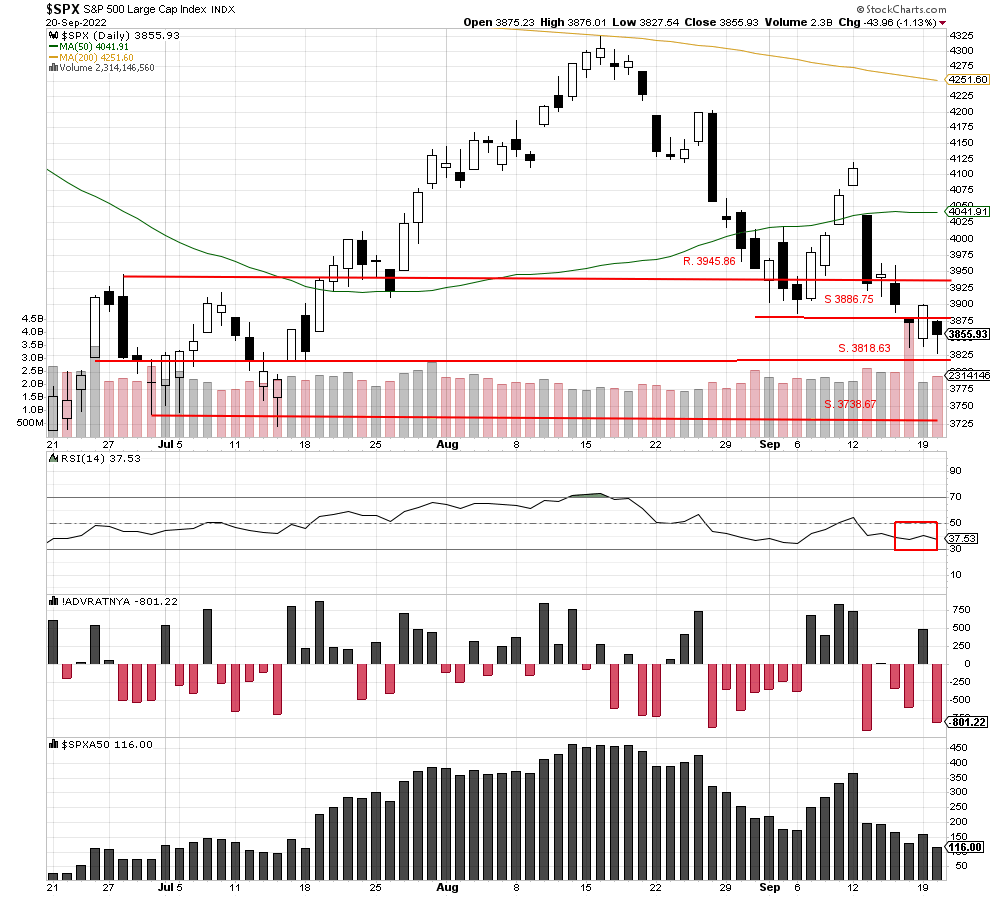Morning Brief

Headline News:
The S&P 500 futures are up 10 points and are trading 0.3% above fair value. The Nasdaq 100 futures are up 4 points and are trading slightly above fair value. The Dow Jones Industrial Average futures are up 88 points and are trading 0.3% above fair value.
Equity futures are in the green but little changed from the flat line. There’s not a lot of conviction ahead of the FOMC decision at 2:00 p.m. ET. The focal point for participants will be the updated terminal rate (from 3.80%) in the Summary of Economic Projections.
In other central bank news, there was continued chatter about Japan intervening in the currency market to strengthen the yen ahead of the Bank of Japan’s policy meeting Thursday. The Asia Development Bank lowered its 2022 growth forecast for China to 3.3% from 5.0% and cut the outlook for 2023 to 4.3% from 5.2%.
Separately, the British government announced a cap on electricity and gas prices for businesses that will be effective from October 1 through March 31.
Russian President Putin announced a partial mobilization of troops in his country’s campaign in Ukraine, boosting the price of oil. WTI crude oil futures are up 2.5% to $86.05/bbl. Natural gas futures are up 4.6% to $8.07/mmbtu.
Treasury yields are moderating this morning. The 2-yr note yield is down two basis points to 3.95%, and the 10-yr note yield is down three basis points to 3.54%.
The weekly MBA Mortgage Applications Index showed a total increase of 3.8% versus last week’s 1.2% decline. Other economic data released today includes August Existing Home Sales (Briefing.com consensus 4.70 million; prior 4.81 million) at 10:00 a.m. ET, weekly EIA Crude Oil Inventories (prior +2.44 million barrels) at 10:30 a.m. ET.
The FOMC rate hike decision and updated Summary of Economic Projections are out at 2:00 p.m. ET, followed by Fed Chair Powell’s press conference at 2:30 p.m. ET.
(Michael Gibbs, Director of Equity Portfolio & Technical Strategy)
Markets:
The S&P 500 tested resistance at 3886.75 only to fail and close lower at 3855.93. However, the index did move close to potential support at 3818.63 and rallied late in the day. RSI continued to move lower, closing at 37.53, and the down volume was 87% of the overall volume, showing the selling could be intensifying. The trading could be volatile today after the Fed rate announcement, and possible support at 3818.63 could be tested today.
We are currently Intermediate-term bearish and short-term bearish.


John N. Lilly III CPFA
Accredited Portfolio Management Advisor℠
Accredited Asset Management Specialist℠
Portfolio Manager, RJFS
Partner, DJWMG
Windsor Wealth Planners & Strategist
Futures trading is speculative, leveraged, and involves substantial risks. Investing always involves risk, including the loss of principal, and futures trading could present additional risk based on underlying commodities investments.
The Relative Strength Index (RSI), developed by J. Welles Wilder, is a momentum oscillator that measures the speed and changes of price movements.
The advance/decline line (A/D) is a technical indicator that plots the difference between the number of advancing and declining stocks on a daily basis. The indicator is cumulative, with a positive number being added to the prior number, or if the number is negative, it is subtracted from the prior number.
The A/D line is used to show market sentiment, as it tells traders whether there are more stocks rising or falling. It is used to confirm price trends in major indexes and can also warn of reversals when divergence occurs.
The percentage of stocks trading above a specific moving average is a breadth indicator that measures internal strength or weakness in the underlying index. The 50-day moving average is used for short-to-medium-term timeframes, while the 150-day and 200-day moving averages are used for medium-to-long-term timeframes. Signals can be derived from overbought/oversold levels, crosses above/below 50%, and bullish/bearish divergences.
The Dow Jones Industrial Average (DJIA), commonly known as “The Dow,” is an index representing 30 stocks of companies maintained and reviewed by the editors of the Wall Street Journal. The Russell 2000 Index measures the performance of the 2,000 smallest companies in the Russell 3000 Index, which represent approximately 8% of the total market capitalization of the Russell 3000 Index.
The S&P 500 is an unmanaged index of 500 widely held stocks that is generally considered representative of the U.S stock market. Past performance may not be indicative of future results. Keep in mind that individuals cannot invest directly in any index, and index performance does not include transaction costs or other fees, which will affect actual investment performance. Individual investors’ results will vary. Opinions expressed are those of the author John N. Lilly III, and not necessarily those of Raymond James. “There is no guarantee that these statements, opinions, or forecast provided herein will prove to be correct. “The information contained was received from sources believed to be reliable, but accuracy is not guaranteed. Investing always involves risk, and you may incur a profit or loss. No investment strategy can guarantee success. The charts and/or tables presented herein are for illustrative purposes only and should not be considered as the sole basis for your investment decision. International investing involves special risks, including currency fluctuations, different financial accounting standards, and possible political and economic volatility. Investing in emerging markets can be riskier than investing in well-established foreign markets.
This is not a recommendation to buy or sell any company’s stock mentioned above.
US government bonds and treasury bills are guaranteed by the US government and, if held to maturity, offer a fixed rate of return and guaranteed principal value. US government bonds are issued and guaranteed as to the timely payment of principal and interest by the federal government. Bond prices and yields are subject to change based on market conditions and availability. If bonds are sold prior to maturity, you may receive more or less than your initial investment. Holding bonds to term allows redemption at par value. There is an inverse relationship between interest rate movements and bond prices. Generally, when interest rates rise, bond prices fall, and when interest rates fall, bond prices generally rise.
The Nasdaq 100 (^NDX) is a stock market index made up of 103 equity securities issued by 100 of the largest non-financial companies listed on the NASDAQ. It is a modified capitalization-weighted index. It is based on exchange, and it is not an index of U.S.-based companies.



